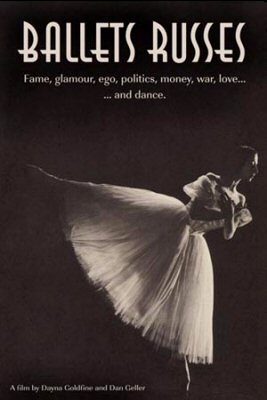Dance/Movie Review: Heart Throbs — “Ballet Russes”
I enjoyed the movie —- critics from outside the dance world have found “Ballet Russes” charming, too — but the filmmakers’ real gifts are the oral histories that they collected from these dancers just before it was too late.
By Debra Cash
Young love never completely fades. The sight of a group of elderly ladies sighing over the perfect physique and gentlemanly mannerisms they remember embodied in the young George Zoritch is the centerpiece of Dan Geller and Dayna Goldfine’s sweet new documentary Ballets Russes, which is at the Landmark Cinemas in Kendall Square, Cambridge and other screens in New England.
Based around a 2000 reunion of dancers who performed with the two companies that picked up —- and competed for —- the mantle of the iconoclastic modern art troupe that stormed Paris in 1909 and ran until its impresario, Serge Diaghilev, died in 1929, the film is less a documentary about the inner workings of the ballet world than a “strangers in good company” feel-good movie. It demonstrates that while beauty and youth can never be forgotten, their traces remain evident long into old age.
Zorich himself is seen working out in a gym near his home in Tuscon, but the real thrill is seeing him in his prime in heroic photos and in magically unearthed film clips. He’s poignant stumbling sweetly after his long-ago partner, a coquettish Nathalie Krassovska, in a moment from the “he loves me, he loves me not” duet from “Giselle.”
The documentary’s title performs the same slight of hand as the rivals to Diaghilev’s mantle did back in the 1930s: it draws on the reputed glamour of the “real” Russian company to cast light on the way two would-be successors took up the challenge of living up to –and profiting off of– the original company’s reputation. The film focuses on the rivalry between Colonel Wasily de Basil’s Ballets Russes, and the breakaway troupe led by dancer and choreographer Leonide Massine. The film systematically shows how the companies emerged from a stew of personal emnity (and tactics that included “raiding” each other’s leading dancers), financial intrigue and sheer marketing acumen.
Showing Balanchine’s preference for the three barely-teenage “baby ballerinas” of Ballets Russes de Monte Carlo (spurning his own former lover, the ancient 27 year old Alexandra Danilova, who had her revenge by continuing her stardom elsewhere) puts a fresh light on his preference for adolescent-shaped women later on (and for shows dance insiders that the young Tatiana Riabouchinska was a dead ringer for later Balanchine star Violette Verdy!) We meet charming old gents, especially articulate, wasp-tongued nonagenarian Frederic Franklin, and are reintroduced to American ballet-turned-Hollywood dancer Marc Platt (who was forced to change his name to the Russified Platoff!) who seems like a worthy challenger to Donald O’Connor.
Audiences get a glimpse into ballet’s early explorations of multiracialism, too. The film explores the careers of both Native American ballerinas Yvonne Chouteau and Maria Tallchief (the latter of whom became one of the greatest American dancers of the century), and also the thwarted career of the light-skinned African-American ballerina Raven Wilkinson, who danced on tours of the American south despite misgivings.
The film makes a few weird historical mistakes that should have been caught (Massine was not the first choreographer to create “symphonic” ballets, he just marketed them that way), but these are quibbles for specialists.
I enjoyed the movie —- critics from outside the dance world have found it charming, too — but Geller and Goldfine’s real gifts are the oral histories that they collected from these dancers just before it was too late, and the excerpts of astonishing footage of dances I never imagined I’d get a chance to see. Wishes for next Christmas? A DVD version of Ballets Russes with the unedited dance footage from those bygone performances.
Debra Cash, Executive Director of Boston Dance Alliance, www.bostondancealliance.org, is a founding Senior Contributor to The Arts Fuse and a member of its Board of Directors. In 2017 she was honored as Champion of the Arts by OrigiNation Cultural Arts Center.
c 2005 Debra Cash

